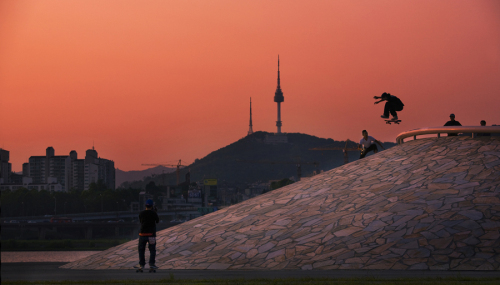New-arrivals to Korea would be forgiven for thinking the skateboarding scene here was non-existent.
Visit any purpose-built skate park and you will likely find a few kids perambulating around on bikes or miniature plastic cars, and perhaps the odd inline skater.
But don’t be fooled.
“Korea is like skate heaven,” said Phil Song, president and co-founder of skateboard suppliers Kadence Distribution.
He puts this down mostly to the lack of “blockers” usually found in countries with a more established scene to prevent skateboarding along with the prevalence of marble and granite surfaces ― naturally sourced in Korea and great for skateboarding.
Preferring pre-existing ledges and obstacles to skate parks, the community has discovered alternative spots. In Seoul, skaters flock to Cult, beside the hospital in Dongdaemun, but each major city has a similar area.
A successful petition by skaters led to a series of modifications to the public plaza, which has a stream running through it. The square now features ramps and rails, and is the location for events and contests ― both local and international.
Last year, Korea hosted about seven skateboarding competitions. Magera Park has been involved in the community for 13 years and organized the summer Busan World Best Trick contests on Haeundae beach, and other events, to help raise the sport’s profile.
For him, skateboarding brings together people with its artistic, fun characteristics, and he also loves that it enables contact with people of other nationalities.
“One of the good points about skateboarding is the relationships developed with foreigners. Most foreign skaters are good riders, friendly and very popular among the Korean skateboard community,” he said.
Brion Baer, from California, arrived in Seoul in November. Although the scene here is smaller than he’s used to, he said, “It’s a cool scene.”
“There are many good places out on the streets to skate (but) the parks aren’t so great.”
In Seoul, popular areas other than Cult include Tteoksom Resort, Yongsan Station and Nanji Park. Many also take to the sidewalks and road at night when there is less traffic.
Neilson Laing has been skateboarding here for several years and appreciates that due to fewer regulations here, skaters are free to explore new spots. “That’s what’s cool to me,” he said.
Although the scene relies a lot on word-of-mouth, the Daily Grind website is a hub of information, providing news, interviews, photos and videos, and details of “Monthly Grinds,” which are organized meet-ups. The site is in part English, part Korean.
Visit any purpose-built skate park and you will likely find a few kids perambulating around on bikes or miniature plastic cars, and perhaps the odd inline skater.
But don’t be fooled.
“Korea is like skate heaven,” said Phil Song, president and co-founder of skateboard suppliers Kadence Distribution.
He puts this down mostly to the lack of “blockers” usually found in countries with a more established scene to prevent skateboarding along with the prevalence of marble and granite surfaces ― naturally sourced in Korea and great for skateboarding.
Preferring pre-existing ledges and obstacles to skate parks, the community has discovered alternative spots. In Seoul, skaters flock to Cult, beside the hospital in Dongdaemun, but each major city has a similar area.
A successful petition by skaters led to a series of modifications to the public plaza, which has a stream running through it. The square now features ramps and rails, and is the location for events and contests ― both local and international.
Last year, Korea hosted about seven skateboarding competitions. Magera Park has been involved in the community for 13 years and organized the summer Busan World Best Trick contests on Haeundae beach, and other events, to help raise the sport’s profile.
For him, skateboarding brings together people with its artistic, fun characteristics, and he also loves that it enables contact with people of other nationalities.
“One of the good points about skateboarding is the relationships developed with foreigners. Most foreign skaters are good riders, friendly and very popular among the Korean skateboard community,” he said.
Brion Baer, from California, arrived in Seoul in November. Although the scene here is smaller than he’s used to, he said, “It’s a cool scene.”
“There are many good places out on the streets to skate (but) the parks aren’t so great.”
In Seoul, popular areas other than Cult include Tteoksom Resort, Yongsan Station and Nanji Park. Many also take to the sidewalks and road at night when there is less traffic.
Neilson Laing has been skateboarding here for several years and appreciates that due to fewer regulations here, skaters are free to explore new spots. “That’s what’s cool to me,” he said.
Although the scene relies a lot on word-of-mouth, the Daily Grind website is a hub of information, providing news, interviews, photos and videos, and details of “Monthly Grinds,” which are organized meet-ups. The site is in part English, part Korean.

Equal opportunities
Apart from U.S. military personnel, who often have skate parks on base, the foreign and Korean skateboarding scenes are integrated, with everyone occupying the same spaces regardless of ability, age, gender or style. This may be due to the small size of the community, having reached a peak around 2002-04.
But, said Shin Jeong-hyuck of Murasaki Sports, things are changing. With people more interested in all types of board sports such as surfing and long boarding, and a youthful zest for street culture, he feels the scene is being reinvented.
“Riders’ attitudes have changed a lot,” he added. “People started to be more patient with each other, teaching each other and trying to understand each other more to enjoy the sport together.”
A great thing about skateboarding, too, said Song, is that language poses few barriers. “Koreans know all the slang like you would use back at home.”
“With skateboarding its pretty easy to meet people worldwide … and that’s the way it is here,” he said, adding that almost all skaters have good conversational English skills too, often learnt skating with foreigners.
Korea also lacks some of the cliques and “hate” that exists in other skateboarding communities he added. This often extends to onlookers too, as even elderly men and women are more likely to watch with intrigue rather than scorn.
Although he has yet to see a female foreigner take to a board here, he has noticed that the Korean scene is less dominated by men than at home: “I’ve never seen so many girl skaters in my life.”
Laing contested to the diverse and friendly atmosphere: “There’s no discrimination at all.” He enjoys being a part of the community too, helping skaters practice their English for instance and being an ambassador for the sport.
Breaking down barriers
But for all the positives, there are big barriers. Korea cannot currently compare with other Western or Asian countries such as Thailand and Japan, where the sport is well-recognized.
For those who are really serious, there is little in the way of support or sponsorship, for any nationality, said Song. And as a sport that needs to be encouraged and harnessed early on, Korea lacks the ability to take gifted youngsters up to the international stage.
Baek Seung-hyun of StuntB Skateboards in Itaewon said that due to a lack of awareness of the sport, “sincere support for local skateboarders is very rare and difficult (to find).”
“There needs to be an association that can represent skateboarders and help build an organized system including skateboarding competitions, youth lessons and indoor park construction,” he suggested.
Song added that as well as a culture which takes guys out for military service for two years and sees the sport more as a game, there is no established path to becoming professional.
“The biggest barrier I guess is no community support from the people who have power, which are the distributors. They do it a very Korean way,” referring for instance to the lack of involvement of people knowledgeable about skateboarding.
His company, which markets skateboarding the American way, as most other countries do, hopes to make it more accessible ― to both Koreans and foreigners.
As a Korean-Canadian, able to communicate with and understand both parties, he hopes he will be able to make inroads. Foreigners can also purchase goods via PayPal, without having to verify one’s identity as a non-Korean.
Skate shops have been doing their bit too, providing not just the equipment but sponsorship where possible for events and talented skateboarders, including foreigners.
Laing, knowing that shops can’t stock the latest gear unless they shift their current stock, likes to frequent Tussa Skateboards in Itaewon: “I try to go and buy something every time I get paid just to support them.”
While some are content for the scene to remain underground, others, like Song, hope it will expand and thrive, because for them, it is much more than just a sport.
“It’s a passion, it’s a lifestyle. I mean I’ve been skating forever, all my life and I don’t know what I would do if I wasn’t skating,” said Song.
By Hannah Stuart-Leach (hannahsl@heraldcorp.com)
Useful links
• Daily Grind: www.dailygrind.kr
• Kadence Distribution: www.kadencedist.com
• Tussa Skateboards: www.tussamall.com
• StuntB Skateboards: www.stuntb.com
• Murasaki Sports: www.murasakisports.co.kr



![[Exclusive] Korean military set to ban iPhones over 'security' concerns](http://res.heraldm.com/phpwas/restmb_idxmake.php?idx=644&simg=/content/image/2024/04/23/20240423050599_0.jpg&u=20240423183955)

![[Graphic News] 77% of young Koreans still financially dependent](http://res.heraldm.com/phpwas/restmb_idxmake.php?idx=644&simg=/content/image/2024/04/22/20240422050762_0.gif&u=)



![[Pressure points] Leggings in public: Fashion statement or social faux pas?](http://res.heraldm.com/phpwas/restmb_idxmake.php?idx=644&simg=/content/image/2024/04/23/20240423050669_0.jpg&u=)










